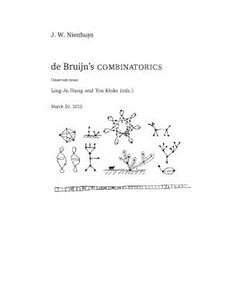
Combinatorics [Lecture notes] PDF
Preview Combinatorics [Lecture notes]
J. W. Nienhuys de Bruijn’s COMBINATORICS Classroomnotes Ling-Ju Hung and Ton Kloks (eds.) March 20, 2012 In honor of N. G. de Bruijn and J. W. Nienhuys. Preface These are Nienhuys’ lecture notes on a course given by de Bruijn starting in thelate1970sandallthroughthe1980s.Wethoughtitwastimetotranslate thisclassictextintoEnglish. This text emphasizes the study of equivalences in enumeration methods. Nowadays, much research in graph theory and graph algorithms focuses on tree-decompositions of graphs. In order to obtain efficient algorithms using thesetree-structures,agoodunderstandingofequivalentsolutionsandequiv- alenttree-structuresareofimmenseimportance.Morethanothertextsinba- sic combinatorics, this text emphasizes enumeration techniques and thereby trains a student to recognize equivalent combinatorial objects. The center of thebookisPo´lya’senumerationtheory.Thistheoryiswithoutdoubtthebest developed general tool for the enumeration of, e.g., geometrical and chemi- cal objects that are equivalent under certain group operations. The chapters on generating functions and permutations slowly build up to the chapter on Po´lya’s theory. The chapter on graphs further emphasizes enumerations of trees under certain equivalences. The chapter on bipartite graphs turns the attention in the direction of algorithmics. It emphasizes covering and repre- sentativeproblems. Games are widely studied in mathematics, economics, and computer sci- ence. The chapter on games is a playful introduction, by various nim games, intoGrundyfunctiontheory. Translatingthistextbroughtoneofusbackintotheclassroom,listeningto deBruijnexplaininghiscombinatorics.Thesenotesaretrueclassroomnotes; the teachings of de Bruijn were written down verbatim by Nienhuys and the blackboard material was copied in numerous figures. This gives the text a unique,almostmagical,speedandclaritywhichonecannotfindinothertext books. The original text lacked exercises. Besides ‘ordinary’ exercises, we have tried to incorperate various classic papers here, of e.g., van der Waerden, Berge, Tutte and, of course, de Bruijn. The student is guided through these beautifulpapersinastep-by-stepmanner. VIII Preface We taught this course in the spring-semester 2010 to undergraduate stu- dents at the Department of Computer Science and Information Engineering ofNationalChungChengUniversity,Ming-Shiun,Chia-Yi,Taiwan.Theenthu- siasm with which our students welcomed this course surpassed our wildest dreams.Itprovedtousthat,withoutdoubt,thepreservationofthistextwill bringpleasuretomanygenerationsofcombinatoricsstudentstocome. We are deeply indebted to professor Dan Buehrer for proofreading and correctingourEnglishtranslation. This project was supported by the National Science Council of Taiwan undergrantsNSC97-2811-E-194-001andNSC99-2218-E-007-016.Wethank theNationalScienceCouncilofTaiwanfortheirsupport. Ling-JuHung DepartmentofComputerScienceand InformationEngineering NationalChungChengUniversity Ming-Shiun,Chia-Yi,621,Taiwan TonKloks DepartmentofComputerScience NationalTsingHuaUniversity Hsinchu,Taiwan. Contents 1 Introduction................................................ 1 2 GeneratingFunctions........................................ 3 2.1 Smallchange ........................................... 6 2.2 Asummationformula .................................... 7 2.3 Multisets ............................................... 11 2.4 Theweighingproblem ................................... 13 2.5 Partitionsofnumbers .................................... 14 2.6 Notes .................................................. 17 2.7 Problems ............................................... 18 3 Permutations ............................................... 23 3.1 Theshepherd’sprinciple.................................. 23 3.2 Permutations............................................ 24 3.3 Stirlingnumbers ........................................ 27 3.4 Partitionsofsets......................................... 29 3.5 Arrangementsofmultisets ................................ 31 3.6 Numberedpartitions ..................................... 33 3.7 Problems ............................................... 34 4 Po´lyatheory ................................................ 39 4.1 Blackandwhitecubes.................................... 39 4.2 Cycleindex ............................................. 41 4.3 Cauchy-Frobeniuslemma................................. 42 4.4 Coloringsandcolorpatterns .............................. 45 4.5 Po´lya’stheorem ......................................... 46 4.6 Invariantcolorings....................................... 53 4.7 Superpatterns .......................................... 57 4.8 Wreathproduct ......................................... 64 4.9 Problems ............................................... 66 X Contents 5 Graphs ..................................................... 75 5.1 Introduction ............................................ 75 5.2 Moreintroduction ....................................... 76 5.3 Trees .................................................. 80 5.4 Pru¨fercode ............................................. 84 5.5 Countingtrees .......................................... 86 5.6 Cayley’sfunctionalequation .............................. 88 5.7 UD-encoding............................................ 94 5.8 KE-encoding ............................................ 97 5.9 Countingalcohols .......................................100 5.10 Thematrixtreetheorem..................................102 5.11 Eulergraph.............................................109 5.12 Linegraph ..............................................112 5.13 DeBruijnsequence ......................................114 5.14 Spanningtrees ..........................................122 5.15 Problems ...............................................124 6 Bipartitegraphs.............................................131 6.1 Introduction ............................................131 6.2 Covering–andrepresentativesproblem ....................133 6.3 TheoremofKo¨nigandHall ...............................134 6.4 TheoremofKo¨nigandEgerva´ry ...........................136 6.5 Latinsquares ...........................................138 6.6 TheoremofFord-Fulkerson ...............................139 6.7 Problems ...............................................144 7 Graphsandgames ..........................................159 7.1 Introduction ............................................159 7.2 Pay-offfunction .........................................161 7.3 Nim ...................................................163 7.4 Grundyfunction.........................................165 7.5 Wijthoffgame...........................................166 7.6 Othergames ............................................169 7.7 Problems ...............................................170 References .....................................................173 Index ..........................................................175 1 Introduction N.G.deBruijngaveacourseinCombinatoricsduringthe1980satEindhoven University of Technology. During the course J. W. Nienhuys took notes. This isatranslationofthesenotes. What is combinatorics? You could say that combinatorics is that part of mathematics that concerns itself with finite systems. But this is not entirely true:thetheoryoffinitegroups,ringsandfieldsdoesnotbelongtocombina- torics. Itiswithcombinatoricsasitiswithasymptotics.Youwouldliketodefine asymptotics as the theory of limits, but large parts of the differential– and integration-calculusdonotbelongtoasymptotics. Foralongtimecombinatoricsconsistedonlyofpuzzlesandgames.Before the1960stherewasprobablynocourseincombinatorics. Combinatorics is mainly about counting. The nice thing about counting is that you learn something about the thing that you are counting. While counting,younoticethatyourknowledgeaboutthesubjectisnotsufficiently precise,andsocountingbecomesaneducationalactivity.Whentwosetshave the same number of elements, you try to understand why that is the case by establishingsomenaturalbijectionbetweenthetwo. N.G.deBruijnrecallsthatsometimearound1975,hecountedthenumber ofacertaintypeoflogicswiththreevariables.Therewerealotofthem;some number with 14 digits. A little while later he saw an article that was about something completely different, but it concluded that the number of those objectswasexactlythatsamenumberwith14digits.Hegotcuriousandread thearticleverycarefully.Indeed,ifyouthoughtdeeplyaboutityoucouldsee thatyoucouldinterpretthoseobjectsalsoaslogics. Where is combinatorics applied? There is a lot of counting going on in statistics;andincomputersciencecombinatoricsplaysaroleinconsiderations aboutcomplexity. Let’sjuststart,anddosomecombinatorics. 2 Generating Functions Oneveryoldideaincombinatoricsistheideaofthegeneratingfunction.This ideacanbetracedbacktoLaplace. Givenaninfinitesequence a ,a ,a ,... 0 1 2 of numbers, then the generating function of that sequence is the following series: A(x)=a +a x+a x2+... 0 1 2 Thetechniqueofthegeneratingfunctionisthatyoutrytofollowthenext flowchart: knowledge about translation knowledge thesequence −−f−or−w−a−r−d→ aboutA(x) operations more knowl- translation more kynowledge edge about thesequence. ←b−ac−k−w−a−r−d−s aboutA(x) ThisflowchartisabitlikethatoftheLaplaceintegral F(x)= extf(t)dt. Z0∞ Theanalogousflowchartis:
